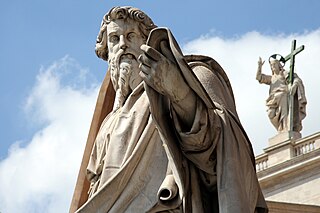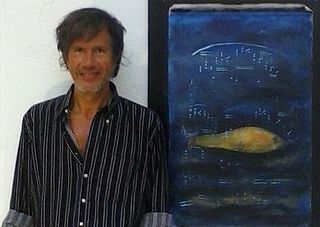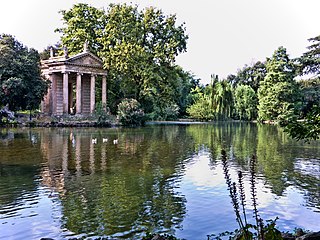Related Research Articles

L'Osservatore Romano is the daily newspaper of Vatican City State which reports on the activities of the Holy See and events taking place in the Church and the world. It is owned by the Holy See but is not an official publication, a role reserved for the Acta Apostolicae Sedis, which acts as a government gazette. The views expressed in the Osservatore are those of individual authors unless they appear under the specific titles "Nostre Informazioni" or "Santa Sede".

The Galleria Borghese is an art gallery in Rome, Italy, housed in the former Villa Borghese Pinciana. At the outset, the gallery building was integrated with its gardens, but nowadays the Villa Borghese gardens are considered a separate tourist attraction. The Galleria Borghese houses a substantial part of the Borghese Collection of paintings, sculpture and antiquities, begun by Cardinal Scipione Borghese, the nephew of Pope Paul V. The building was constructed by the architect Flaminio Ponzio, developing sketches by Scipione Borghese himself, who used it as a villa suburbana, a country villa at the edge of Rome.

Achille Bonito Oliva is an Italian art critic and historian of contemporary art. Since 1968 he has taught history of contemporary art at La Sapienza, the university of Rome. He has written extensively on contemporary art and contemporary artists; he originated the term Transavanguardia to describe the new direction taken in the late 1970s by artists such as Sandro Chia, Francesco Clemente, Enzo Cucchi, Nicola De Maria, and Mimmo Paladino. He has organised or curated numerous contemporary art events and exhibitions; in 1993 he was artistic director of the Biennale di Venezia.

Giuseppe Pellizza da Volpedo was an Italian divisionist painter. He was born and died in Volpedo, in the Piedmont region of northern Italy.

Mimmo Paladino is an Italian sculptor, painter and printmaker. He is a leading name in the Transvanguardia artistic movement and one of the many European artists to revive Expressionism in the 1980s.
Guglielmo Janni, was an Italian painter belonging to the modern movement of the Scuola romana .
Emanuele Cavalli (1904–1981) was an Italian painter belonging to the modern movement of the Scuola Romana. He was also a renowned photographer, who experimented with new techniques since the 1930s.

Eduardo Dalbono was an Italian painter born in Naples.
Silvana De Stefano is an Italian sculptor and architect.
Giovanni Piancastelli was an Italian painter and architect.

Bruno Ceccobelli is an Italian painter and sculptor. He currently resides and works in Todi, Italy. Ceccobelli was one of the six artists of the Nuova Scuola Romana or Scuola di San Lorenzo, an artistic movement that grew out of the Arte Povera and Transavanguardia movements of the latter twentieth century.

Adamo Tadolini was an Italian sculptor. One of a family of sculptors, he studied in Rome with the neo-classical sculptor Antonio Canova and is linked to him in style.

Giuseppe Prinzi (1825–1895) was an Italian sculptor.

Paolo De Grandis is an Italian contemporary art curator and president of PDG Arte Communications. He lives currently in Venice.
Vittorio Orsenigo is an Italian short story writer, novelist and theater director. Most of his fame came in the later years of his life, as he developed his career as a writer when he was almost 80.

Corrado Veneziano is an Italian painter, visual artist, television and theater director.
Luca Pignatelli is an Italian artist.

Sergio Sarra is an Italian artist and former basketball player.
Renato Barisani was an Italian sculptor and painter.

Pinciano is the 3rd quartiere of Rome (Italy), identified by the initials Q. III. The name derives from the Pincian Hill. It belongs to the Municipio II.
References
- ↑ Cf. Marco Vallora, La 'naja' in nero e pastello, in: Il Giornale, 11 April 1991.
- ↑ Cf. Ducrot, Giuseppe, in: Istituto dell'Enciclopedia Italiana, Lessico del XXI Secolo (2012); and Achille Bonito Oliva, Giuseppe Ducrot (exhibition catalogue, ARCO 20.02.2015–10.05.2015), Rome 2015, p. 142.
- ↑ Extensively in Achille Bonito Oliva 2015, pp. 134–139.
- ↑ Cf. Alfonso Feola, La statua bronzea di San Benedetto a coronamento di una nuova rotaria, in: GazzettaRegionale, 12 July 2015.
- ↑ Cf. The Pope blesses the statue of St Hannibal Mary, in: L’Osservatore Romano, 8 July 2010; Benedizione della statua di Sant'Annibale Maria di Francia – 7 luglio 2010, in: La Basilica di S. Pietro 22/7 (2010), pp. 1–2.
- ↑ Cf. Die unruhige Besorgnis des Vorläufers Jesu, Eine neue Statue von Giuseppe Ducrot in der Basilika Santa Maria degli Angeli e dei Martiri, in: L’Osservatore Romano, 22 June 2012.
- ↑ Cf. Alyssa Bird, The Most Attractive New Bar on the Amalfi Coast, in: Architectural Digest, 31 July 2015.
- ↑ Cf. Jakob Wetzel, Auferstehung in der Theatinerkirche, in: Süddeutsche Zeitung (online), 3 May 2017.